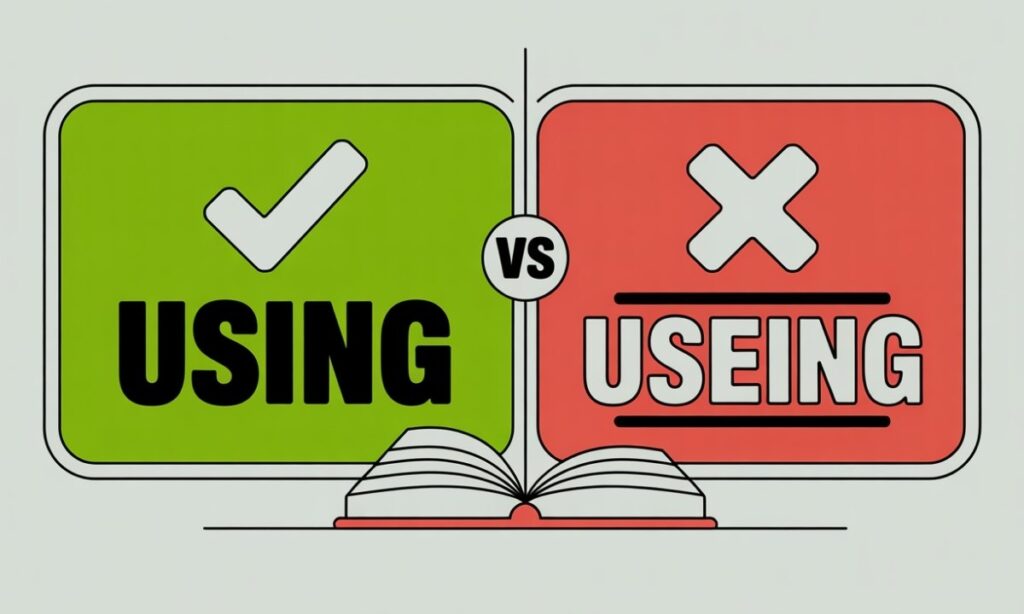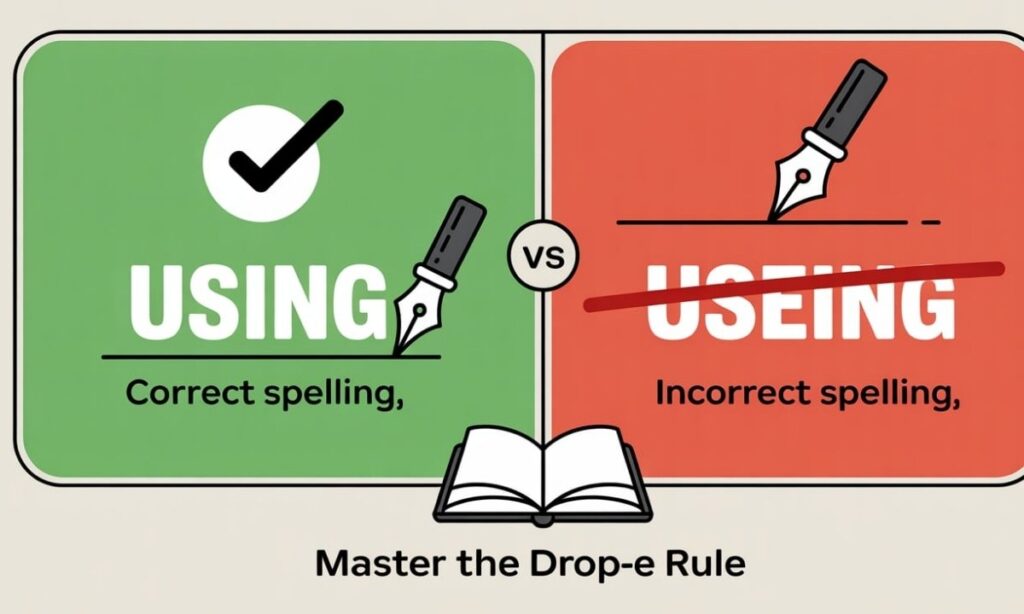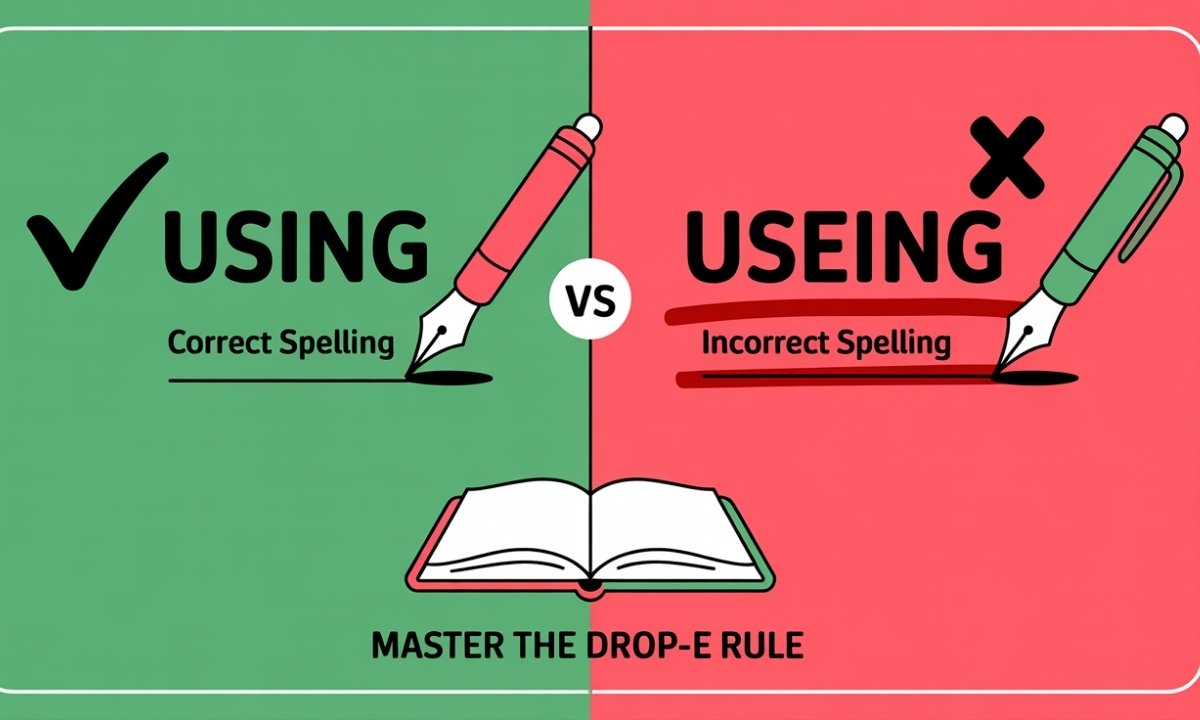Ever paused mid-sentence, fingers hovering over your keyboard, wondering if you’re spelling “using” correctly? You’re not alone. This spelling confusion trips up countless writers daily, from students crafting essays to professionals composing critical emails. Here’s the straightforward truth: “using” is correct, and “useing” is wrong. Always.
Understanding this correct spelling isn’t just about avoiding embarrassment. It’s about maintaining credibility in every word you write. This guide breaks down the grammar comparison between these two forms, explores the drop the e rule, and equips you with practical writing tips that’ll make proper spelling second nature.
Understanding Using and Useing
The spelling difference between these terms creates widespread confusion among English learners and native speakers alike. But here’s what you need to know upfront: only one has legitimate standing in English dictionaries.
“Using” follows standard English conjugation patterns. “Useing” doesn’t exist in accurate spelling conventions. Period. This common misspelling stems from uncertainty about how verbs change when adding “-ing” endings. Many writers hesitate because English spelling rules can seem inconsistent and confusing.
Using: Definition and Usage
“Using” functions as the present participle of the verb “use.” This verb form appears in progressive tenses, serves as a gerund, and acts as a participle in various sentence structures. The word originates from Old French “user,” evolving through Middle English into modern usage.
As a participle usage, “using” creates continuous tenses: “I am using,” “they were using,” “we will be using.” As a gerund, it functions as a noun: “Using proper grammar matters.” As a modifier, it describes: “The man using the phone is my colleague.”
Common contexts include:
- Technology applications: “She’s using the latest software version”
- Resource management: “Companies are using sustainable materials”
- Problem-solving: “Using logic helps solve complex equations”
- Everyday actions: “I’m using my lunch break wisely”
Useing: Definition and Usage
Let’s be crystal clear: “useing” isn’t a valid English word. No dictionary recognizes it. No grammar authority accepts it. No professional context tolerates it.
This represents a frequent misspelling that immediately signals incorrect spelling to readers. Spellcheckers flag it automatically with aggressive red underlines. Using this form in writing correctness contexts damages your credibility instantly, whether in academic papers, business proposals, or casual correspondence.
There are no regional variations, no historical exceptions, no alternative forms. “Useing” simply represents a spelling mistake born from confusion about English conjugation rules.
Side-by-Side Comparison
This detailed comparison illuminates why one spelling works while the other fails completely:
| Feature | Using | Useing |
| Dictionary Status | Recognized worldwide | Not recognized anywhere |
| Grammatical Role | Valid present participle | Invalid form |
| Professional Acceptance | Universal approval | Universal rejection |
| Spellcheck Recognition | Always accepted | Always flagged as error |
| Usage Frequency | Millions of daily occurrences | Zero legitimate uses |
| Historical Validity | Established for centuries | Never valid |
This usage contrast shows no ambiguity. The language analysis is straightforward: choose “using” every single time.
Key Differences
Understanding the grammar difference requires examining several critical factors that separate correct from incorrect forms:
Grammatical Validity: Only “using” follows established English spelling rules. The verb modification process drops silent -e before adding -ing, creating the proper usage form that linguists and grammarians universally accept.
Formation Pattern: The drop the e rule governs this transformation. When verbs ending in silent -e receive -ing endings, that final letter disappears. Use → using. Make → making. Write → writing.
Professional Recognition: Every style guide—AP, Chicago, MLA, APA—accepts “using” without question. These authorities immediately flag “useing” as a typo issue requiring correction.
Spellcheck Behavior: Modern word processors, email clients, and writing platforms recognize “using” instantly. They reject “useing” with error notifications, preventing writing errors before publication.
Etymology Consistency: “Using” aligns with English language evolution patterns established over centuries. The spelling rule that creates it applies consistently across thousands of similar verbs.
The Root of the Confusion
Why does this common mix-up plague so many writers? The answer lies in English spelling’s notorious unpredictability.
The language tip here involves understanding silent letters. When “use” stands alone, that final -e stays silent but present. Some writers assume adding -ing means keeping every existing letter, creating the incorrect form “useing.”
Other verbs following identical patterns:
- Hope → hoping (not hopeing)
- Chase → chasing (not chaseing)
- Amuse → amusing (not amuseing) -Lose → losing (not loseing)
- Close → closing (not closeing)
The grammar technique requires recognizing that silent -e serves specific purposes in base words but becomes unnecessary when suffixes starting with vowels get added. This ing addition naturally replaces the silent letter’s function.
English doesn’t always sound like it’s spelled. Learners from languages with more phonetic consistency struggle with these quirks. The spelling problem intensifies when rushed typing bypasses conscious thought about rules.
Email Correspondence

Professional email demands accurate spelling without exception. A single spelling mistake in critical correspondence can undermine months of relationship-building.
Business email examples showing proper usage:
- “I’m using the analytics platform you recommended”
- “Thank you for using our consulting services”
- “We’re using a collaborative approach this quarter”
- “Are you using the updated templates?”
Email clients typically catch “useing” automatically through built-in spellcheckers. However, rushed composition often bypasses proofreading, letting frequent misspellings slip through. The error prevention strategy? Read every email aloud before sending.
Stakes escalate with executive communication, client correspondence, and external partnerships. One incorrect spelling won’t destroy your career, but patterns of careless errors gradually erode professional trust.
Academic Writing
Academia maintains zero tolerance for common errors in scholarly work. Professors, peer reviewers, and academic journals scrutinize every word for writing correctness.
Academic contexts requiring precision:
- “Researchers are using innovative methodologies to track migration patterns”
- “Using statistical analysis, we determined correlation coefficients”
- “The study examined environmental factors using controlled experiments”
- “Using qualitative interviews, participants revealed unexpected themes”
Major style guides (APA, MLA, Chicago) emphasize grammar accuracy throughout citation formats, methodology sections, and analytical discussions. Graduate committees reject theses containing persistent typical errors, viewing them as evidence of insufficient attention to detail.
The writing correction process in academia often involves multiple peer reviews, faculty advisor feedback, and institutional editing services. Still, writers bear ultimate responsibility for correct spelling throughout their work.
Business Proposals
Proposal writing stakes couldn’t be higher. Companies win or lose six-figure contracts based partly on perceived professionalism, which includes flawless accurate spelling.
Proposal sentences demonstrating proper form:
- “Our team proposes using cutting-edge blockchain technology”
- “Using this strategy will increase ROI by estimated 40%”
- “Clients benefit from using our integrated platform approach”
- “We recommend using phased implementation over six months”
Purchasing managers and decision committees review dozens of competing proposals. They’ll often eliminate submissions containing frequent mistakes, reasoning that companies careless with proposals might prove equally careless with project execution.
Multiple stakeholders typically review proposals before submission. Yet spelling confusion sometimes survives these checks when reviewers focus on content over mechanics. The proofreading tips section later provides strategies preventing such oversights.
Social Media Posts
Social platforms permit more casual tones, but correct spelling still matters significantly for brand image and personal credibility.
Social media examples:
- “Anyone else using this productivity app? Game-changer!”
- “Quick tips for using hashtags effectively across platforms”
- “I’m using my platform to raise awareness about climate action”
- “Stop using outdated marketing tactics. Here’s what works now”
Influencers, thought leaders, and brands maintain grammar accuracy standards even in casual posts. Viral content spreads rapidly—including mistakes. A common misspelling in a widely-shared post amplifies embarrassment exponentially.
The writing tips for social media balance conversational authenticity with professional standards. Contractions and informal language work fine. Blatant spelling errors don’t.
Everyday Usage Examples
These daily examples demonstrate “using” across diverse common scenarios:
Technology & Tools:
- “I’m using my smartphone for navigation today”
- “She’s using Photoshop to edit wedding photos”
Cooking & Food:
- “He’s using fresh ingredients from the farmer’s market”
- “Try using olive oil instead of butter”
Problem-Solving:
- “Using critical thinking skills solves most workplace challenges”
- “They’re using creative approaches to budget constraints”
Resources & Energy:
- “Homeowners are using solar panels increasingly”
- “Using public transportation reduces carbon footprints”
Time & Schedules:
- “Stop using all my free time!”
- “I’m using mornings for deep creative work”
Relationships:
- “He keeps using me for free advice”
- “Are you using that sympathetic tone sarcastically?”
This usage demonstration shows the word’s versatility across literal and figurative contexts. The sentence structure remains consistent regardless of meaning.
Synonyms for Using
Expanding vocabulary prevents repetitive word comparison while maintaining meaning:
Alternative words:
- Employing: “Businesses are employing remote work models”
- Utilizing: “Utilizing available resources maximizes efficiency”
- Applying: “Students are applying theoretical knowledge practically”
- Implementing: “Teams are implementing new safety protocols”
- Operating: “She’s operating sophisticated medical equipment”
- Wielding: “He’s wielding considerable influence in negotiations”
- Exercising: “Exercising diplomatic skills resolved the conflict”
- Deploying: “Companies are deploying AI-powered chatbots”
Each synonym carries subtle differences. “Utilizing” sounds more formal than “using.” “Wielding” implies power or force. “Deploying” suggests strategic positioning.
Language guidance suggests varying vocabulary stylistically while maintaining core meaning. However, knowing synonyms doesn’t excuse the wrong usage of “useing.”
Techniques to Remember Correct Spelling

These memory tricks cement proper usage permanently:
1. Drop the -E Rule
This spelling rule provides the foundation. Silent -e disappears before -ing additions consistently. The formula: use + -ing = using (drop the e).
Practice with parallel examples. Love becomes loving. Hope becomes hoping. Drive becomes driving. The pattern repeats across hundreds of verbs, making it a reliable grammar technique.
2. Visualization
Visual learners benefit from mental imagery. Picture “using” spelled correctly in bold, capital letters. Imagine red squiggly lines crossing out “useing” like spellcheck does.
Create physical flashcards showing the correct and incorrect sentences. This learning method reinforces recognition through repeated visual exposure.
3. Mnemonic Rhymes
Catchy phrases stick in memory: “Drop the E before ING, that’s the spelling rule for everything.”
Or try: “Using is amusing when you lose the E.” Creating personal mnemonics leverages rhythm and rhyme for enhanced retention.
4. Repetition Practice
Write “using” correctly twenty times daily. Type it repeatedly in your word processor. Incorporate deliberate practice into everyday writing strategies.
Muscle memory develops through consistent repetition. Your fingers eventually type the correct spelling automatically without conscious effort.
5. Check Similar Words
Group related words following identical patterns. Lose→losing. Chase→chasing. Amuse→amusing. This language tip builds pattern recognition across multiple verbs simultaneously.
Understanding broader rules beats memorizing individual words in isolation.
6. Associate with Synonyms
Connect “using” with “utilizing,” which doesn’t contain -e to drop. Link it to “employing” and other alternatives. This usage guide approach reinforces correct spelling through vocabulary relationships.
7. Say It Out Loud
Auditory learning strengthens spelling retention. Pronounce “using” carefully while writing. Notice how “useing” sounds awkward when enunciated deliberately.
Read your work aloud during proofreading. Hearing mistakes often catches what eyes miss.
8. Review Common Mistakes
Study frequently misspelled words lists. Keep a personal error log tracking your specific typical error patterns. Review before important writing assignments.
Learning from past writing errors prevents future repetition systematically.
Tips to Avoid Mistakes
Implement these proofreading tips for consistently error-free writing:
- Proofread everything: Never skip final review before sending
- Enable spellcheck: Use automatic checking in all applications
- Read backwards: Catches spelling mistakes better than forward reading
- Take breaks: Fresh eyes spot frequent misspellings more easily
- Practice regularly: Daily writing improves spelling naturally
- Learn underlying rules: Understanding why prevents misunderstanding
- Create checklists: Include spelling review in writing processes
- Request peer reviews: Others catch what you miss
- Use grammar tools: Grammarly, ProWritingAid
- Stay humble: Everyone makes mistakes occasionally
Correct And Incorrect Sentence of Using and Useing
This sentence comparison shows writing correction clearly:
✓ Correct Usage:
- “I’m using a new recipe tonight”
- “She’s using her experience wisely”
- “Using proper grammar matters professionally”
- “They’re using renewable resources”
- “Are you using the right tools?”
- “Using this method saves time significantly”
✗ Incorrect Usage:
- “I’m useing a new recipe tonight”
- “She’s useing her experience wisely”
- “Useing proper grammar matters professionally”
- “They’re useing renewable resources”
- “Are you useing the right tools?”
- “Useing this method saves time significantly”
Context never changes this grammar rule. “Useing” never appears correctly regardless of surrounding words or intended meaning.
Popularity Analysis
Search data reveals fascinating patterns about this spelling confusion. Google Trends shows thousands monthly search “useing correct spelling” and related variations—evidence of widespread uncertainty.
Google Ngram Viewer, which tracks word frequency in published books, shows “using” appearing millions of times across centuries. “Useing”? Zero legitimate occurrences in quality publications.
The high search volume for this common misspelling actually helps readers. It indicates content addressing the confusion serves genuine needs. Writers seeking clarity benefit from authoritative usage guides clarifying the distinction definitively.
According to Merriam-Webster and Oxford English Dictionary, “using” remains the only recognized spelling across all English-speaking regions globally.
Frequently Asked Questions(FAQ’s)
Why do people often misspell “using” as “useing”?
People forget the drop-e rule when adding -ing suffixes.
Are there any other common words where people make similar spelling mistakes?
Yes: hoping, making, writing, losing, chasing follow identical patterns.
Is “useing” ever correct in any context or dialect?
No, “useing” is never correct in any English dialect.
What are some tips for avoiding the mistake of writing “useing”?
Remember drop-e rule, use spellcheck, proofread carefully, practice regularly.
Conclusion
The using vs useing debate isn’t actually a debate. “Using” is correct; “useing” is wrong. Simple as that.
The drop the e rule governs this spelling: silent -e disappears before -ing additions. This grammar comparison applies across professional emails, academic papers, business proposals, social media, and everyday writing without exception.
Master the techniques to remember outlined here. Practice the tips to avoid mistakes consistently. Soon, proper spelling becomes automatic habit rather than conscious effort.
Everyone makes spelling mistakes occasionally. What separates good writers from careless ones? Good writers learn from errors, apply rules consistently, and prioritize writing correctness in everything they create.
Bookmark this usage guide for quick reference. Share it with colleagues, students, or anyone struggling with this particular language mistake. Most importantly, practice using—spelled correctly—this common word confidently in your daily writing.
Your credibility depends on getting small details right. Start with spelling “using” correctly every single time.

